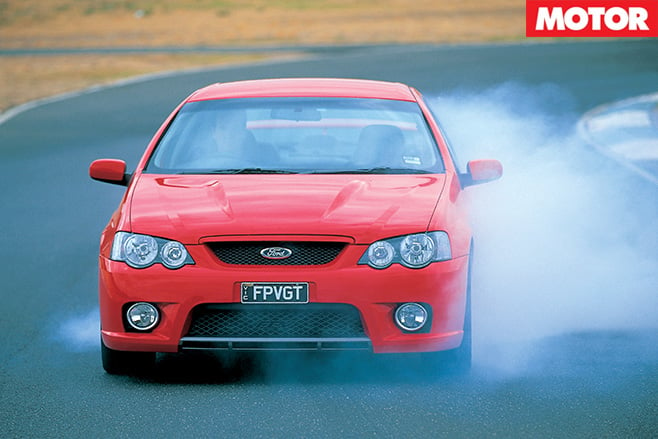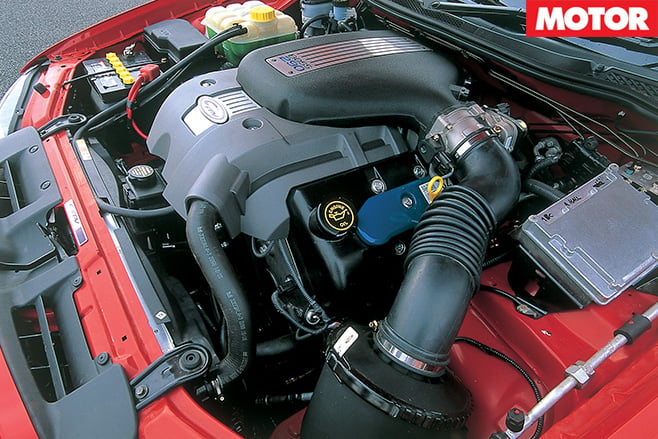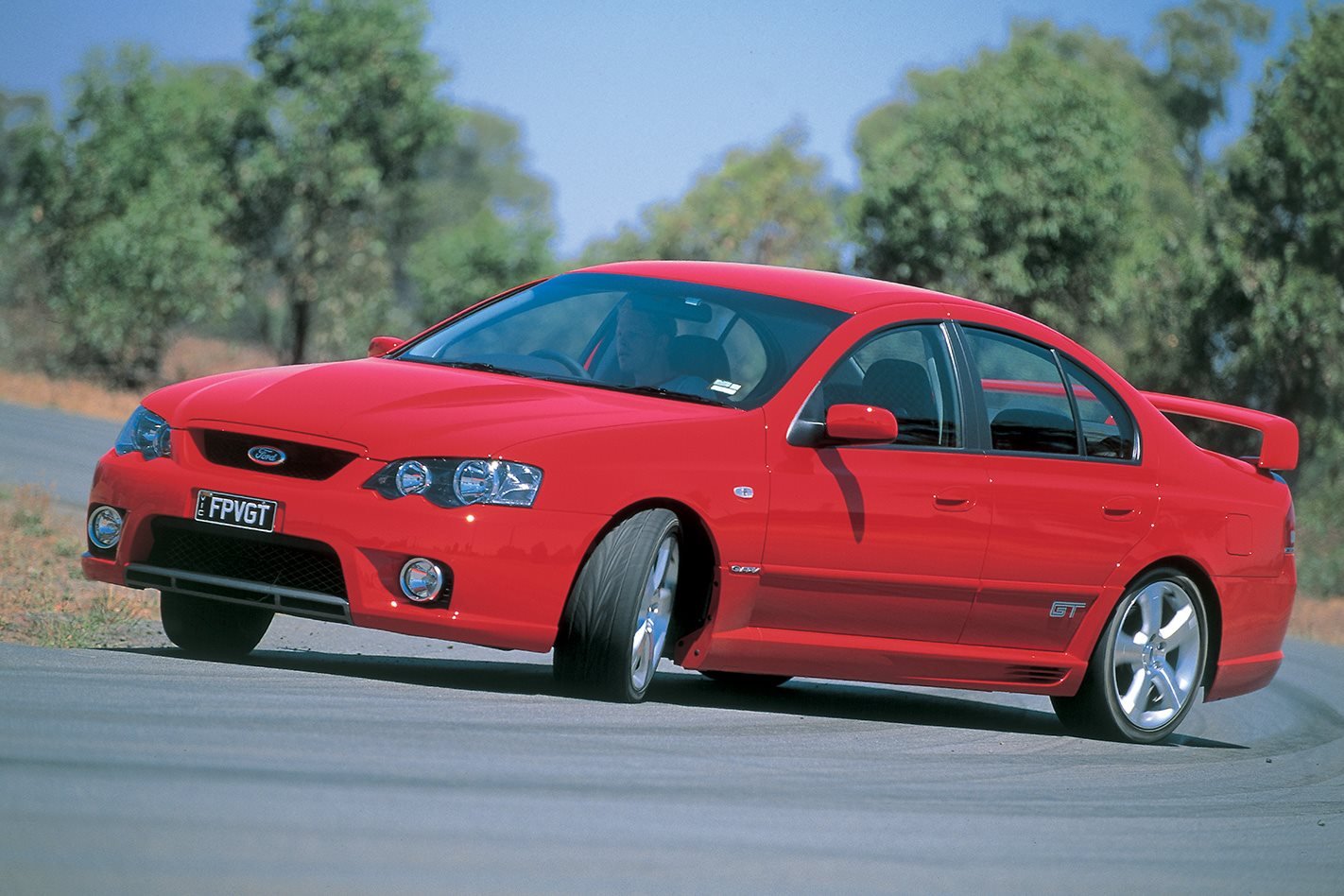The Ford fight back starts at the touch of a button.
This article was originally published in the March 1997 issue of MOTOR.
Twist the ignition key, punch the glowing red circle high on the driver’s left side of the instrument panel and the big Boss 290 motor fires into life, then settles to a slightly uneven idle that gently shakes the BA Falcon’s solid frame.
What follows is something Ford fans, or anyone into hot sedans, has been looking forward to for years. A GT that’s fast and noisy, sits fat on the road and screams to the world that Ford Australia is right back in the performance car game.
Is the GT enough to have the boys at HSV quaking in their boots? You’d want to hope that Ford Performance Vehicles, as the old Tickford operation is now known, has its act together sufficiently to give certain rivals across town a good kicking in the slats. After all, it has been a few years, a couple of 1990s GT Falcons that never captured the public’s imagination and the Titanic-sized disaster of the AU Falcon is all ancient history. Now is the time for Ford to lift itself off the mat, and the GT is being seen as the ultimate counter-attack.

As you’ve probably read, the GT is the next step up the ladder. Along with the more luxurious (but mechanically identical) GT-P, it is now a permanent model in the FPV line-up, not a toe-in-water limited edition cash-grabber like the old EB and EL.
Plenty has gone into this car, starting with the total revamp of the AU that became the BA. Add to that the twin cam, 32-valve XR8 engine upgraded from 260 to 290 kW, toss in lots of suspension work, and the GT adds to what is a burgeoning performance portfolio from Broadmeadows.
In dollar terms, it’ll set you back $59,850 for the basic five-speed manual GT, although there’s also a four-speed auto for another $1150. The interior is based on the XR8, meaning it gets the entry level stereo and air conditioning display, with the auto climate control jobby reserved for the GT-P. You do get cruise control, six-stacker CD, traction control, ABS and 18-inch alloys, but leather, sports steering wheel and a metal gear knob are extra cost options.

The top end changes are no less dramatic. A new camshaft gives 13 mm of lift on the inlet side compared with the XR8’s 10 mm, and exhaust valves open an extra two millimetres. Valve stems are longer to cope with the extra lift, finger followers are also longer, and the Visteon engine management system is overhauled for the new parameters.
It all sounds like FPV was looking for more revs and top-end power from its new and very undersquare V8 which, in SOHC form, is a low-speed, smooth and torquey unit, but not really a fire-breathing hotty at the top end. To that end, the outputs speak for themselves: Not only is there 30 kW more than the XR8, but it is produced 250 rpm higher in the rev range at 5500 rpm. Torque goes from 500 to 520 Nm, and again it peaks 250 rpm higher up, at 4500 instead of 4250 rpm.

But first, let’s get the weight issue out of the way. No two ways about it, at 1835 kg, the GT is a heavy bastard. It’s about 40 more than the already-porky XR8. That equates to a power-to-weight calculation of 6.3 kg/kW, so even with an HSV GTS-like power output, the engine is going to be working hard.
Just getting the GT off the line is an issue in itself: on Calder’s rubbery drag strip anything more than about 1800 rpm before dumping the clutch set the rear Dunlops alight, and there was enough axle tramp to give the Correvit (kindly donated by our friends at Victoria’s RACV tech dept after our beloved unit pooped itself) a hernia of sorts.
Revving the Boss out to its 6000 rpm cut-out in second just managed to get the GT to 100 km/h before the five-speed Tremec was brutalised with a bang into third, but to cross the 400 metre line yet another shift was needed into fourth. All the while, the big V8 is producing big power on the way to its redline, matching the abundant torque that gave it so much trouble off the start.

Practice kind of makes perfect, or in this case, GT acceleration times a little quicker than at Calder. Thanks to lower-than-recommended tyre pressures and a goodly number of attempts to match the perfect launch with the shift points, we got quicker. Still hard to get off the line, but 0-100 km/h in 5.81 sec and 400 metres in 14.06 is better, if still not in the same league as Holden’s heroes.
So after all the hype, is the GT actually a slug, given that only the most insane owner would go to all the trouble of producing these sorts of times? There’s no doubt the GT’s weight counts against it, as does the gearing of the Tremec five-speed requiring three shifts over the quarter, and then there’s the lack of traction off the line. In any public bar argument, it’s safe to say something like a 300 kW HSV GTS (costing about $30,000 more, don’t forget) has the GT’s measure.

The quest for top end power has also been achieved, but that’s not to say this is a peaky engine like Holden’s Gen III. Simply, the featherbed of torque turns into a raging torrent of horsepower as revs rise, with a noticeable increase in urge over 4000 rpm. There’s no red line marked on the tachometer, and it says a lot for such a large capacity and long-stroke V8 that it needs a weather eye to stop it banging off that 6000 rpm limiter.
It’s also something of a dolly to drive. The pedals might be off-set to the right, as in any BA Falcon, but clutch efforts are light, the fly-by-wire throttle is well modulated, and the shift action of the Tremec is so much quicker and more positive than the T5 in the XR6 Turbo that it’s not funny. There might not be quite the no-brainer lightness of a Toyota Corolla, but it puts to rest forever the theory that a muscle car needs muscle to pedal.
And did we mention the noise? Glorious. The twin-pipe exhaust set-up exiting through a single oval tip under the right-rear bumper might not look overwhelming, but the throaty howl it emits under full throttle, or the little tunes you can play at other times, justify the 60-grand entry price alone.

Whatever it is, there’s great stability with just a hint of tram-lining over longitudinal ridges. The overall impression on the road is of great solidity, which together with low noise levels and the powerhouse punch of the engine give something of the old iron-fist, velvet-glove feeling.
It is, however, a big, heavy car and while that shouldn’t necessarily affect the handling, this is no MX-5 on the twisty bits. The 18-inch wheel and tyre package is the same as the XR8’s (and indeed, as you can see in the pics our GT wore XR8 rims while it awaited the production items) which are enough to give the front end bite, while adding significantly more weight to the steering than the standard and overly light Falcon set-up.

Standard brakes are FPV’s Performance items, meaning grooved discs and twin-piston calipers on the front, and they work extremely well at hauling the GT’s mass down from speed while retaining a progressive and communicative pedal. Spend another $5950 and you get the Brembo package with bigger (try 355 mm at the front) cross-drilled rotors, with four-piston calipers front and rear.
The GT copped some criticism for looking too mild when first displayed at the Sydney show last year, although those critics may have forgotten that a GT is meant to be a warmed-over Falcon, not an exercise in plastic moulding. Otherwise you end up with the EL GT. Urrk.

Inside there are grippy seats with GT badging, although the natty leather/suede combo is optional as is the spiffy metal gearshift knob. Instruments get FPV logos as backing and are a bit hard to read, and there are the usual BA foibles of switchgear hidden by the steering wheel (but you soon get used to finding the ‘traction off’ button), the off-set pedals and that gearknob can get too hot to touch in warm weather.
So, then. No excuses for the performance which, if not disappointing in ultimate terms, barely matches even a standard Subaru WRX. But raw figures only tell half the story, because the GT engine’s huge flexibility means the driver never feels it lacks anything on the road.

We think they will.
SPECS Body: four-door sedan Drive: rear Engine: 5.4-litre, 32-valve DOHC V8 Power: 290 kW at 5500 rpm Torque: 520 Nm at 4500 rpm Compression ratio: 10.5:1 Bore x stroke: 90.2 mm x 105.8 mm Weight: 1835 kg Weight/power: 6.3 kg/kW Specific power: 53.7 kW/litre Transmission: five-speed manual Suspension: double wishbones, coil springs, anti-roll bar (f); Control Blade IRS, coil springs, anti-roll bar (r) Length/Width/Height: 4920/1864/1435 mm Wheelbase: 2829 mm Track: 1560 mm (f); 1575 mm (r) Brakes: 325 mm grooved, ventilated discs, twin-piston calipers (f); 303 mm grooved, solid discs, single-piston calipers (r) Wheels: 18 x 8.0-inch (f & r), alloy Tyres: Dunlop SP Sport 9000, 235/40 ZR18 (f & r) Fuel: 68 litres, PULP Price: $59,850
FAST FIGURES 0-10 0.53 0-20 1.06 0-30 1.53 0-40 1.98 0-50 2.44 0-60 2.98 0-70 3.78 0-80 4.41 0-90 5.10 0-100 5.81 0-110 6.96 0-120 7.98 0-130 8.96 0-140 10.09 0-150 11.24 0-160 12.88





